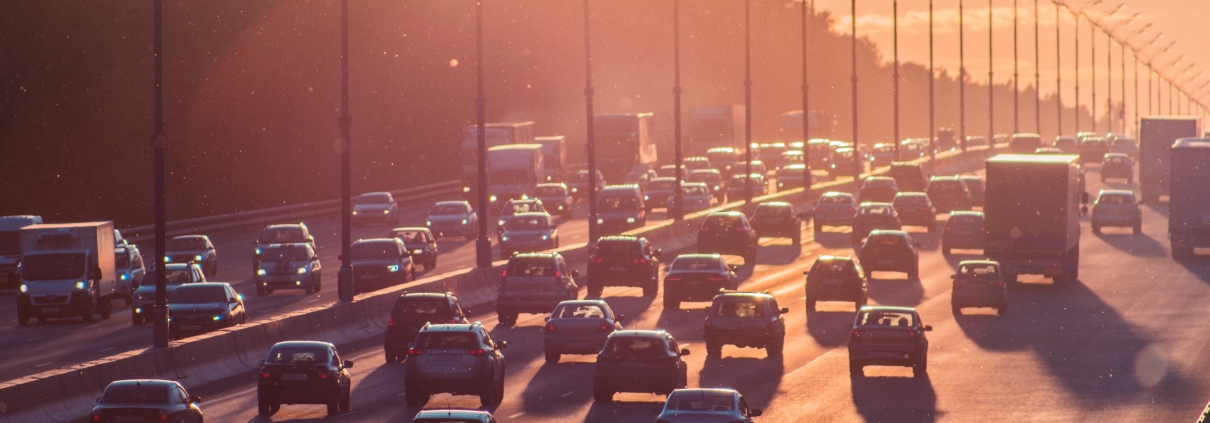Traffic & Air Quality – The Influence of Mobility on Urban Air Pollution
Air pollution is the greatest environmental health risk, killing approximately 7 million worldwide every year. Ambient air pollution accounts for 4.2 million of those deaths, of which traffic and mobility are a major source. Global transport carbon dioxide (CO2) emissions in 2018 totalled 8 billion tonnes, of which 74% came from road vehicles. Given that 55% of the world’s population live in urban areas, which tend to have the most traffic, city dwellers are at highest risk with the resulting air pollution. Let’s take a look at the relationship between traffic and air quality, and how that’s developed over the years.
How does traffic contribute to urban air pollution?
The petrol and diesel engines of cars emit pollutants such as carbon monoxide (CO), nitrogen oxides (NOx), particulate matter (PM), sulfur dioxide (SO2), and volatile organic compounds (VOCs) that contribute to poor urban air quality. Even electric vehicles can contribute towards air pollution if the energy they use is generated by conventional means, such as coal power plants. Additionally, friction from tires and brake wear create primary PM emissions. The nitrogen dioxide (NO2) and VOCs released by road vehicles undergo photochemical reactions to form ground-level ozone (O3), otherwise known as photochemical smog in cities.
What is the health impact of air pollution from traffic?
People who live near roads with heavy traffic within a 300-500 metre distance are particularly vulnerable to illnesses such as childhood asthma, impaired lung function and cognition, premature death and death from cardiovascular diseases. They are also at a higher risk of developing chronic obstructive pulmonary disease (COPD) and dementia.
How has air pollution from transportation developed over time?
In the United States, the Clean Air Act of 1970 gave the then-newly-formed Environmental Protection Agency (EPA) the legal authority to regulate emissions from cars and other forms of transportation. As a result, lead was eliminated from fuels, sulfur levels are 90% lower than prior to regulation, and new vehicles are 98-99% cleaner for most common pollutants compared to those from the 1960s. Every $1 USD spent to reduce emissions from mobile sources results in $9 USD of benefits to public health, the environment, productivity, and consumer savings. By 2030, EPA air quality emissions standards for vehicles are expected to annually prevent 40,000 premature deaths, 34,000 avoided hospitalizations, and 4.8 million lost work days. However, today, the transportation sector still remains responsible for 55% of total NOx emissions in the country.
In the European Union, sulfur oxides (SOx) emissions from road transport have dropped by 99%, non-methane volatile organic compounds (NMVOCs) by 89%, carbon monoxide (CO) emissions by 88%, and nitrogen oxides (NOx) by 60% since 1990. However, primary PM2.5 emissions from braking, tire wear, and road abrasions have increased by 22% since 2000. In 2017 specifically, non-exhaust PM2.5 accounted for 46% of emissions from the road transport sector.
What does the sustainable future of mobility look like?
Overall, air pollution generated by traffic has decreased over the years across many nations thanks to environmental legislation and developments in vehicle technology. These include diesel particulate filters, which capture soot in order to reduce tailpipe emissions, and electric vehicles. Both still contribute to air pollution, however. As such, there is still much to be done in the way of improving mobility for future smart, sustainable cities. Research has shown that creating infrastructure for vehicles actually encourages people to use them more, thus exacerbating traffic. The best solution, then, is to invest in infrastructure and legislation that increases the quality of life for individuals.
Development strategies that have proven successful for the transport sector therefore include:
- Establishing tax schemes to discourage diesel vehicles
- Improving reliability, affordability, and accessibility of public transportation
- Encouraging walking and cycling by improving pedestrian and bicycle paths
- Limiting and charging for urban parking options to discourage traffic in cities
- Prioritizing compact development of urban spaces to reduce vehicle travel demands
- Establishing low emission zones
- Implementing congestion charges to discourage driving
- Investing in vehicle and fuel technologies
A comprehensive air quality network is imperative in order to best assess the effectiveness of these initiatives and support urban planning initiatives. At Breeze Technologies, we provide a solution that monitors and improves air quality of cities. Our proprietary sensors measure for all major air pollutants emitted by traffic. The sensors are small and compact, perfect for deployment on street lights and other city infrastructure. They provide real-time hyperlocal air quality data, which is then analyzed and presented on our Breeze Environmental Intelligence Cloud. Municipalities can thus track urban development activities, immediately identify issues, and make improvements to their strategies for a more sustainable mobile future. Contact us today for more information!



 unsplash.com / Tuva Mathilde Løland
unsplash.com / Tuva Mathilde Løland